Disclosure: We may earn commissions if you purchase products after clicking on a link from our site.
Do you want to learn how to catch white bass? White bass has been overlooked by many anglers; however, you can find it all year round and it is a tasty fish.
White bass is aggressive and a hard-fighting fish when caught. In this article, we will discuss the best methods to catch white bass, the fishing gear, baits, and lures, as well as its behaviors to improve your chances of successfully fishing for white bass.
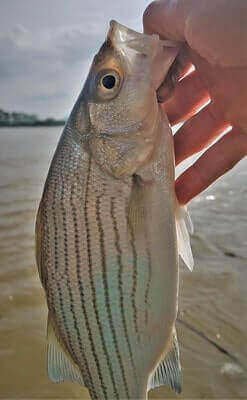
Table of Contents
- 1 How To Catch White Bass
- 2 Best Bait For White Bass
- 3 Best Lures For White Bass
- 4 White Bass Tackle Setup
- 5 Best Rig For White Bass
- 6 How To Catch White Bass In Rivers
- 7 How To Catch White Bass From Shore
- 8 How To Catch White Bass In Lakes
- 9 How To Catch White Bass In Creeks
- 10 How To Catch White Bass In The Summer
- 11 How To Catch White Bass In Winter
- 12 How To Catch White Bass In The Fall
- 13 How To Catch White Bass In Autumn
- 14 White Bass Fishing Tips
- 15 The Bottom Line
How To Catch White Bass
1. Trolling
Trolling is a productive method for covering large areas of water and locating schools of white bass. Anglers use trolling rods and reels equipped with diving plugs, crankbaits, or spinner rigs to tow lures behind a moving boat. By adjusting the speed and depth of the lures, anglers can target white bass at different depths and locations within the water column.
This method is effective in open water, along channel edges, or around points and drop-offs where white bass often congregate. Trolling allows anglers to efficiently search for active fish and cover a variety of depths and structures. For more information on this method, visit United States Geological Survey.
2. Casting and Retrieving
Casting and retrieving is a popular method for catching white bass, particularly when they are actively feeding near the surface. Anglers use lightweight spinning or baitcasting tackle to cast lures such as spoons, spinners or crankbaits into areas where white bass are schooling.
By mimicking the movements of baitfish, anglers can entice strikes from white bass. Varying the speed and depth of retrieval can help match the activity level and preferences of the fish. This method is effective in covering large areas of water and locating actively feeding schools of white bass. For more information on this method, visit US Fish and Wildlife Service.
3. Vertical Jigging
Vertical jigging is a productive technique for catching white bass, especially when they are holding near structure or in deeper water. Anglers use a jigging rod and reel setup to drop lures vertically through the water column, targeting suspended fish. Jigging spoons, blade baits, or soft plastic jigs are commonly used for this method.
By varying the jigging motion and depth, anglers can effectively trigger strikes from white bass. This method is particularly effective during periods of low light or when white bass are holding tight to structure. For more information on this method, visit National Oceanic and Atmospheric Administration.
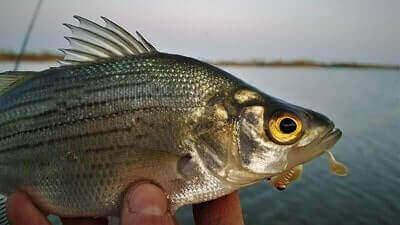
4. Fly Fishing
Fly fishing for white bass is an exhilarating pursuit that offers anglers a unique challenge and an opportunity to connect with nature. Utilizing lightweight fly rods, reels, and specially designed flies, anglers can effectively target white bass in a variety of habitats, from rivers and streams to lakes and reservoirs.
Successful fly patterns for white bass mimic natural prey items such as minnows, crayfish, and aquatic insects, enticing strikes from these voracious predators. Anglers can improve their chances of success by accurately casting their flies to likely holding areas, such as submerged structure, drop-offs, and current breaks.
By varying the retrieve speed and pattern, anglers can effectively imitate the movement of baitfish and trigger aggressive strikes from white bass. Fly fishing for white bass requires patience, finesse, and a keen understanding of the fish’s behavior and habitat preferences. For more information on how to catch white bass using fly fishing techniques, anglers can refer to resources provided by the U.S. Fish and Wildlife Service at https://www.fws.gov/.
5. Live Bait Fishing
Live bait fishing is a traditional and effective method for catching white bass, particularly when they are feeding selectively or in heavily pressured waters. Anglers use live baitfish such as shad, minnows, or nightcrawlers rigged on hooks or under floats to entice strikes from white bass.
This method allows anglers to present a natural and enticing offering to the fish, especially in situations where artificial lures may be less effective. Live bait fishing can be done from shore, boats, or fishing piers, making it accessible to anglers of all skill levels. For more information on this method, visit US Department of the Interior.
Best Bait For White Bass
- Minnows
Minnows are one of the most effective baits for catching white bass due to their natural appearance and enticing movement in the water. Anglers can catch minnows using a variety of methods, including cast nets, dip nets, minnow traps, or by purchasing them from bait shops.
Once acquired, anglers can rig the minnows on hooks using a variety of techniques, such as hooking them through the lips or dorsal fin to ensure natural presentation and maximum movement. When fishing for white bass, anglers can either cast the rigged minnows near structure or along shorelines, or they can present them under floats to suspend them at a desired depth.
By adjusting the depth of the minnow and varying the retrieval speed, anglers can effectively target white bass at different depths and locations within the water column. Minnows are particularly effective during periods of low light or when white bass are actively feeding near the surface. For more tips on how to catch white bass using minnows as bait, anglers can consult resources provided by state fish and wildlife agencies or fishing guide services.
2. Worms
Worms, particularly nightcrawlers or earthworms, are a versatile and readily available bait for targeting white bass. Anglers can find worms in their natural habitat or purchase them from bait shops. Rigging a worm on a hook is simple; anglers can thread the worm onto the hook, leaving a portion dangling to entice strikes.
Alternatively, anglers can use a worm threader to rig the worm more securely and prevent it from sliding off during casting or retrieval. When fishing for white bass with worms, anglers can present them using a variety of methods. One effective technique is to rig a worm on a small jighead and bounce it along the bottom, mimicking natural foraging behavior.
Additionally, anglers can fish worms under floats to suspend them at a desired depth, particularly in areas with submerged structure or along drop-offs where white bass may be holding. Adjusting the depth and varying the retrieval speed can help anglers effectively target white bass throughout the water column.
Worms are a reliable bait option for white bass fishing, especially when presented naturally and in areas where white bass are actively feeding. For more tips on how to catch white bass using worms as bait, anglers can refer to resources provided by state fish and wildlife agencies or fishing guide services.
3. Shad
Shad are a popular and effective bait for catching white bass due to their natural appeal and availability in many freshwater systems. Anglers can catch shad using a variety of methods, including cast nets, dip nets, or by using specialized shad rigs with multiple hooks.
Once acquired, anglers can rig the shad on hooks using various techniques, such as hooking them through the lips or dorsal fin to ensure natural presentation and maximum movement. When fishing for white bass with shad, anglers can either cast the rigged shad near structure or along shorelines, or they can present them under floats to suspend them at a desired depth.
By adjusting the depth of the shad and varying the retrieval speed, anglers can effectively target white bass at different depths and locations within the water column. Shad are particularly effective during periods of low light or when white bass are actively feeding near the surface.
4. Smelt
Smelt serves as a highly effective bait option for anglers targeting white bass, owing to their natural appeal and availability in many freshwater systems. Anglers typically catch smelt using a variety of methods such as cast nets, dip nets, or specialized smelt rigs equipped with multiple hooks. Once acquired, anglers can rig the smelt on hooks using various techniques, such as hooking them through the lips or dorsal fin to ensure a natural presentation and maximum movement.
When fishing for white bass with smelt, anglers can deploy different tactics, including casting the rigged smelt near submerged structures or along shorelines. Alternatively, they can suspend the smelt under floats at desired depths to target white bass at various locations within the water column.
By adjusting the depth and varying the retrieval speed, anglers can effectively entice strikes from white bass. Smelt can be particularly productive during low-light conditions or when white bass are actively feeding near the surface. For more insights on how to catch white bass using smelt as bait, anglers can refer to resources provided by state fish and wildlife agencies or fishing guide services.
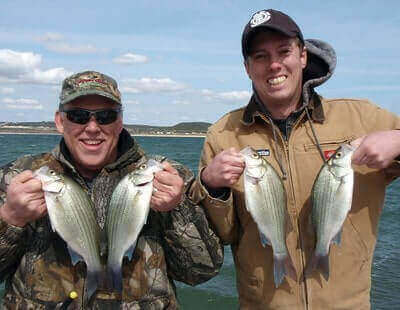
Best Lures For White Bass
- Spoons
Spoons are a popular and versatile lure option for anglers targeting white bass. These lures mimic the appearance and movement of small baitfish, making them highly effective in enticing strikes from white bass. Anglers can choose from a variety of spoon sizes, shapes, and colors to match the forage prevalent in their fishing area.
When fishing for white bass with spoons, anglers can cast them out and retrieve them at varying speeds to mimic the erratic movement of fleeing baitfish. Alternatively, they can vertically jig spoons near submerged structures or along drop-offs where white bass are known to congregate.
Additionally, spoons can be trolled behind a boat at different depths to cover a larger area and locate actively feeding fish. Anglers should experiment with different spoon presentations until they find the most effective technique for the specific conditions. Spoons are particularly effective during periods of active feeding or when white bass are schooling near the surface. For more tips on using spoons as lures for white bass, anglers can consult fishing guides, online resources, or local bait and tackle shops.
2. Spinners
Spinners are a popular and effective lure choice for anglers targeting white bass. These lures feature a spinning blade or blades that create flash and vibration, mimicking the movement of small baitfish and attracting the attention of predatory fish like white bass. Spinners come in a variety of sizes, colors, and blade configurations, allowing anglers to match the local forage and fishing conditions.
When fishing for white bass with spinners, anglers typically cast them out and retrieve them at a steady pace, varying the speed and depth to find the most effective presentation. Additionally, anglers can experiment with different retrieval techniques, such as stop-and-go retrieves or erratic jerks, to trigger strikes from actively feeding white bass.
Spinners are versatile lures that can be used in a variety of situations, including fishing near submerged structure, along shorelines, or in open water. They are particularly effective when white bass are actively feeding near the surface or when targeting fish holding in deeper water.
Anglers can find success with spinners throughout the year, making them a valuable addition to any tackle box when pursuing white bass. For more tips and techniques on using spinners to catch white bass, anglers can consult fishing guides, online resources, or local bait and tackle shops.
3. Crankbaits
Crankbaits are a popular and versatile lure option for anglers targeting white bass. These lures typically feature a diving lip that causes them to dive to specific depths when retrieved, allowing anglers to cover a wide range of water depths and structures.
Crankbaits come in various sizes, shapes, and colors, allowing anglers to match the local forage and water conditions. When fishing for white bass with crankbaits, anglers can cast them out and retrieve them at a steady pace, varying the retrieval speed and depth to find the most effective presentation.
Crankbaits can be particularly effective when fishing near submerged structures, along drop-offs, or in open water where white bass are known to congregate. Additionally, anglers can experiment with different crankbait styles, including lipless crankbaits and diving crankbaits, to determine which works best under specific conditions.
Crankbaits are especially effective during periods of active feeding or when white bass are at different depths in the water column. Anglers can find success with crankbaits year-round, making them a valuable addition to any tackle box when pursuing white bass. For more tips and techniques on using crankbaits to catch white bass, anglers can consult fishing guides, online resources, or local bait and tackle shops.
4. Topwater Lures
Topwater lures are an exciting and effective option for anglers targeting white bass, particularly during times of active feeding or when fishing in shallow waters. These lures typically feature a floating or buoyant design that allows them to remain on the water’s surface during retrieval, creating enticing splashes, ripples, and commotion that attract the attention of predatory fish like white bass.
Topwater lures come in various shapes, sizes, and colors, including poppers, prop baits, and walking baits, each designed to imitate different types of prey and trigger strikes from white bass. When fishing for white bass with topwater lures, anglers can cast them out and retrieve them using a variety of techniques, such as a steady retrieve, a stop-and-go retrieve, or a “walking the dog” action, where the lure is manipulated to create a side-to-side motion on the surface.
Topwater lures are particularly effective when fishing near submerged vegetation, along shorelines, or in areas with active feeding activity. Anglers should be prepared for explosive strikes when using topwater lures, as white bass often aggressively attack lures presented on the surface. For more tips and techniques on using topwater lures to catch white bass, anglers can consult fishing guides, online resources, or local bait and tackle shops.
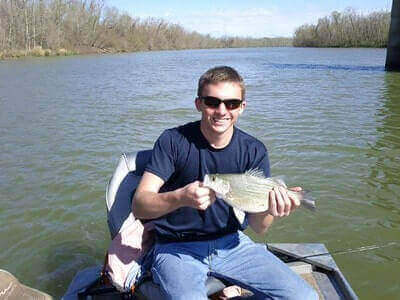
5. Jerkbaits
Jerkbaits are a versatile and effective lure option for anglers targeting white bass. These lures typically feature a slender, minnow-like profile with multiple treble hooks and are designed to mimic the erratic, darting movements of injured baitfish. Jerkbaits come in various sizes, colors, and diving depths, allowing anglers to match the local forage and fishing conditions.
When fishing for white bass with jerkbaits, anglers can employ a “jerk and pause” retrieve technique, where the lure is twitched or jerked with the rod tip to impart erratic movement, followed by a pause to allow the lure to suspend in the water column. This action closely resembles the behavior of injured baitfish, often triggering aggressive strikes from white bass.
Jerkbaits can be particularly effective when fishing in open water, along drop-offs, or near submerged structures where white bass are known to congregate. Anglers should experiment with different retrieval speeds, pauses, and cadences to determine the most effective presentation for the specific fishing conditions.
Jerkbaits are especially effective during periods of active feeding or when targeting larger white bass that are keying in on larger prey. For more tips and techniques on using jerkbaits to catch white bass, anglers can consult fishing guides, online resources, or local bait and tackle shops.
6. Swimbaits
Swimbaits are a popular and effective lure choice for anglers targeting white bass. These lures typically feature a lifelike appearance and swimming action, mimicking the movement of baitfish and triggering strikes from predatory fish like white bass. Swimbaits come in various sizes, shapes, and colors, including soft plastic and hard-bodied versions, allowing anglers to match the local forage and fishing conditions.
When fishing for white bass with swimbaits, anglers can employ a steady retrieve or vary the speed and cadence to imitate the swimming behavior of natural prey. Swimbaits can be particularly effective when fishing in open water, along submerged structure, or near drop-offs where white bass are known to congregate.
Anglers can also experiment with different rigging options, such as using weighted hooks or jig heads, to achieve the desired depth and action. Swimbaits are especially effective when white bass are actively feeding on baitfish or when targeting larger individuals that prefer larger prey. For more tips and techniques on using swimbaits to catch white bass, anglers can consult fishing guides, online resources, or local bait and tackle shops.
7. Jigs
Jigs are versatile and effective lures for anglers targeting white bass. These lures consist of a weighted head with a hook, often adorned with a soft plastic or hair skirt, grub, or other trailer. Jigs come in various sizes, colors, and weights, allowing anglers to customize their presentation based on fishing conditions and preferences.
When fishing for white bass with jigs, anglers can cast them out and retrieve them with a steady, slow, or erratic retrieve, depending on the behavior of the fish and the water conditions. Jigs can be particularly effective when fishing near submerged structure, along drop-offs, or in areas with active feeding activity. They are also highly versatile, allowing anglers to fish them at different depths by adjusting the weight of the jig head or adding additional weight.
Additionally, jigs can be paired with various trailers, such as soft plastic grubs, crawfish imitations, or minnow imitations, to further enhance their effectiveness. Anglers should experiment with different colors, sizes, and retrieves to determine the most effective presentation for the specific fishing situation. For more tips and techniques on using jigs to catch white bass, anglers can consult fishing guides, online resources, or local bait and tackle shops.
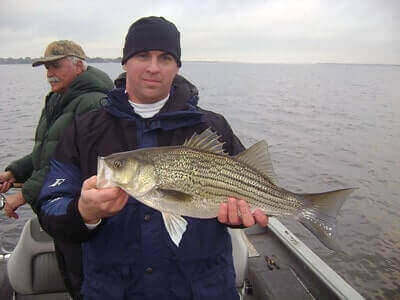
White Bass Tackle Setup
When caught, white bass will put up a serious fight despite its size. Therefore, you want to use a medium action rod with a 6- to 10-pound braided line. A 17-pound fluorocarbon leader is also a good combination with the braided line.
If you fly fish for white bass, a 6wt or 7wt rod will work and allow you to cast small flies very far. Additionally, you will need a full sink line to get the flies quickly down to the fish in deep water.
Best Rig For White Bass
A simple weighted bait rig will work well when fishing for white bass. Add a small casting weight to the fishing line and tie a barrel swivel. Add 2 to 3 feet of light 4- to 6-pound monofilament or fluorocarbon at the other end of the swivel and then tie on a size 8 to 4 bait hook.
Use a minnow rigged through the lips or a worm that is trung halfway onto the hook, starting with the head and the hook point protruding below the band. Cast the rig into the body of water, reel in more slack and just wait for a bite. This is a white bass jig setup that is very productive.
How To Catch White Bass In Rivers
White bass can be found at different water depths. You can catch white bass in rivers all during the year. They move to different water depths during different seasons, but you can catch white bass in rivers. Trolling is one of the fishing methods often used by anglers to catch white bass.
When learning how to catch white bass, you can use baits, such as minnows, smelt, shad, and other baitfish to catch white bass. Lures, like crankbaits and jigs, and flies are also used when fishing for white bass. You can use trolling and baitcasting when fishing for white bass in a river.
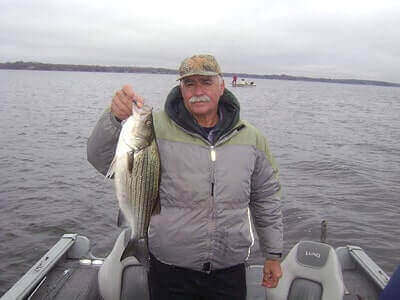
How To Catch White Bass From Shore
White bass can be caught from the shore. During spring when white bass is spawning, you can use live bait to catch white bass from the shore. White bass will move to tributaries of rivers, lakes, and other bodies of water for spawning. This makes it easy to target them as they are in shallow waters.
Baitfish and other small fish like smelt and shad can be used to catch white bass from the shore. You can also use lures and flies to target white bass from the shore. Topwater lures, crankbaits, jerkbaits, and spoons are used when fishing for white bass.
How To Catch White Bass In Lakes
You will need a boat or kayak to fish for white bass in a lake. The large white bass will be found further inshore. Trolling works well when fishing for white bass on a lake. After locating schools of white bass, use crankbaits, spoons, or spinners for casting. Topwater lures can also be used if they are closer to the surface feeding on baitfish.
How To Catch White Bass In Creeks
The best time to go fishing for white bass in creeks is when they are spawning. White bass spawn in shallow water, most often in tributaries close to the main bodies of water. This presents a great opportunity to catch them as the tributaries are shallow and not deep. Baitcasting works and baits and lures are effective when fishing for white bass in creeks.

How To Catch White Bass In The Summer
Summer is an ideal time to catch white bass. White bass moves back to the main bodies of water from the tributaries after spawning. At this time, their appetite is off the charts, and will go after anything to eat. They will go after schools of baitfish like shad, minnows, smelt, and other baitfish.
This is a good opportunity for anglers who are learning how to catch white bass. Target white bass during the summer in water depths of 14 to 28 feet but will move even deeper in the water column as summer continues. Lures and flies can also be used to target white bass during the summer
How To Catch White Bass In Winter
Fishing for white bass during winter is more challenging. They tend to gather in large schools at the bottom of deep water and tend to be stationary. This situation makes it harder for them to bite and the challenge for the angler is to find them and get your baits as close as possible to entice bites. A fish finder is the best option to help you target white bass 30 feet or more in the water column.
To find them that deep in the water column during the winter, you will have to cover a lot of water to find schools of white bass. Vertical jigging is also an effective fishing method to use when fishing during the winter.
How To Catch White Bass In The Fall
During the fall white bass will move into more shallow water as the temperature drops, driving baitfish before them. White bass puts on a lot of weight during the fall, thanks to the abundance of baitfish to feed on. This time of the year will yield large white bass.
White bass is fat and aggressive during the fall and having moved to shallower waters, they are more vulnerable and will go after different lures like jigs, spoons, crankbaits, and jerkbaits.
How To Catch White Bass In Autumn
White bass will migrate to shallow water in the range from 10 to 14 feet, or even less along hard rocky bottoms off the ends of islands and rocky points. This presents a good opportunity for anglers to catch a lot of white bass.

White Bass Fishing Tips
- White bass spawn during the spring. White bass moves to small tributaries during the spring to spawn when the water temperature reaches between 54 to 68 degrees.
2. You can use baits, lures, and flies when fishing for white bass.
3. When caught, white bass will fight aggressively and hard. Despite its small size, white bass has a lot of strength and will put up one heck of a fight; be ready.
4. White bass is a schooling fish that can be found in large schools in different water columns. When learning how to catch white bass, use fish finders to locate large schools of white bass.
5. White bass can be consistently caught all year round, in all seasons.
6. White bass spawn during spring. They move to small tributaries for spawning which is a great opportunity for anglers fishing for white bass.

7. Fishing for white bass is more challenging as they move into deeper water, sometimes 30 feet or more, during the winter. They congregate in stationary schools and tend to be very reluctant to bite.
8. The best time of the day to go fishing for white bass is in the morning. They tend to look for deeper water to escape the sunlight.
9. A fish finder is important when locating white bass. However, closer to the surface, you can keep your eyes open for diving birds or activities on the surface of the water like boils.
10. White bass only feed on baitfish above them or at their level. When learning how to catch white bass, this information can be very helpful as it allows you to make your presentation at the level that you find the white bass.
11. Vertical jigging can also be used when fishing for white bass, especially during the winter.
12. Medium action rods are the favorite of anglers but any variety of fishing rods and reels will work when fishing for white bass.

13. Night fishing for white bass is also productive. The lights will attract the white bass as they fish on baitfish. Use live minnows when fishing for white bass during the night.
14. Flashy lures like jigs, spoons, or spinners can prove irresistible for white bass.
The Bottom Line
White bass is an aggressive and hard-fighting fish found throughout the year. Most fishing methods can be used when learning how to catch white bass. In this article, we shared information about fishing methods, baits, lures, how to set up a white bass rig, as well as tips to catch more white bass.
If you go fishing for largemouth bass, spotted bass, smallmouth bass, or black sea bass, you can read how to catch largemouth bass, how to catch spotted bass, how to catch smallmouth bass, how to catch yellow bass, and how to catch black sea bass to get some tips on how to improve your chances of taking more largemouth bass home.